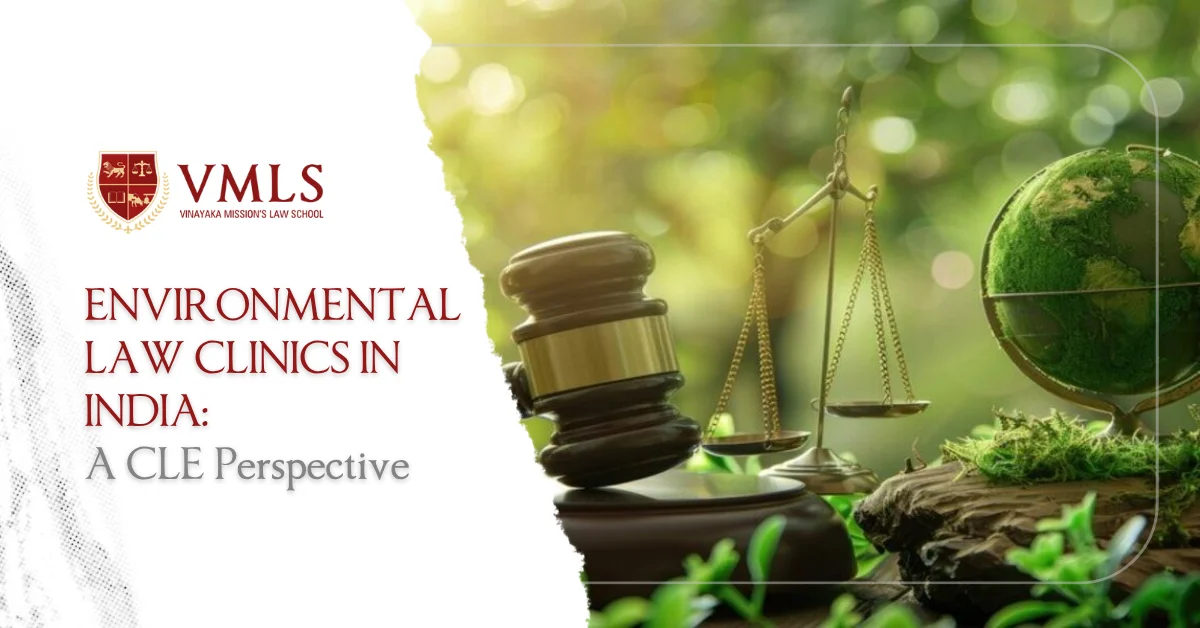June 02, 2025
0 Views

The importance of clinical legal education has been growing awareness as an essential component of modern legal training, where students can learn by practicing themselves, confront actual legal issues, and refine skills via active learning (Stimson, 2018). In this regard, environmental law clinics have evolved as potent instruments for promoting the twin causes of environmental justice and sustainability, especially in situations such as those that obtain in India, where both ecological desecration as well as legal inaccessibility are pressing realities.
Environmental law clinics are the hands-on clinical programs in our law schools that give students the experience they need to understand the intricacies of environmental legal systems, policy, and advocacy (Environmental Law Institute, 2020). These clinics provide the school a unique platform at the crossroads of academia and service with the ability for students to work with distressed communities, non-profit organizations, and government organizations on local and regional environmental problems (Taylor, 2019). Moreover, the inherently interdisciplinary nature of environmental law lends itself to a clinic model that integrates legal analysis with insights from environmental science, public policy, and the social sciences, thus facilitating more holistic and impactful solutions (Karkkainen, 2002).
The Indian situation has a particular urgency for environmental law clinics. The nation is confronted with enormous environmental challenges, characterized by air and water pollution on a massive scale, deforestation, and an increasing severity of climate change (World Bank, 2020). Adding to this are the limited opportunities that are available to many disadvantaged and other communities for obtaining legal redress and professional representation in environmental cases (Agarwal, 2019). Clinics can fill this gap by empowering communities through legal support and awareness while simultaneously building the capacity of students and legal professionals to respond to ecological crises (Singh, 2018).
A few Indian institutions are already in the process of incorporating environmental clinics into their Legal Education Programs. Projects The Centre for Environmental Law at the National Law School of India University (NLSIU) has, for example, been found running projects on environmental advocacy and legal research (NLSIU, n.d.). The Indian Law Institute (ILI) also operates a Centre for Environmental Law, which undertakes research and holds training on environment-related legal and policy issues (ILI, n.d.). These programs offer valuable models for how clinics can be institutionally supported within Indian law schools.
Around the World Environmental law clinics have also demonstrated abroad the change-making power of this model. Harvard Law School is home to the Environmental Law Clinic, which has played a key role in legal advocacy in climate change, environmental health, and pollution control matters (Harvard Law School, n.d.). UCLA Law School has also worked on environmental justice, clean energy access, and sustainable infrastructure projects (UCLA Law, n.d.).
A number of lessons learned from these clinics have been captured. Successful environmental law clinics develop solid partnerships with NGOs and communities, which extends their reach and influence (Taylor, 2019, 158). They also embrace an interdisciplinary approach using science and policy to better appreciate and solve environmental issues (Karkkainen 2002). One of the most remarkable aspect of these clinics is that they focus on empowerment of the community, insisting that people worst affected by environmental abuse must be able to engage effectively in the law (Singh, 2018). Clinics, such as conduit clinics, that take time to regularly record, share, and report out on their activities and experiences help ensure that the knowledge flows more broadly and that these become replicable models (Environmental Law Institute, 2020).
To conclude, environmental law clinics provide one vital tool for bringing together legal education and environmental advocacy in India! Through a balance of experiential learning, interdisciplinary collaboration, and community engagement, these clinics have the potential to be transformative in promoting environmental justice and developing resilient legal and community responses to environmental issues.
Several students across India are choosing law as a career due to the various benefits it offers.
The 3-year LLB (Bachelor of Legislative Law) programme is an undergraduate programme designed to cater...
Vinayak Mission's Law School (VMLS) is one of the best law schools in India and is being mentored by O. P. Jindal Global...
In India, law is seen as a noble career option, and the number of students interested in pursuing law is increasing.
If you are willing to work in a legal advisory firm, judiciary, or as a lawyer, then pursuing a law degree plays...
CLAT is a national-level entrance exam, and it stands for Common Law Entrance Test. Many top law universities in India.